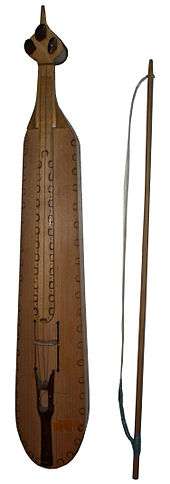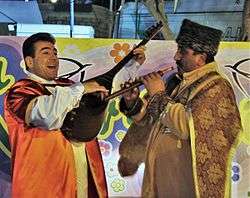Oud
The oud (Arabic: عود[1][2][3] ʿūd [ʕuːd]) is a short-neck lute-type, pear-shaped stringed instrument [4](a chordophone in the Hornbostel-Sachs classification of instruments), usually with 11 strings grouped in 6 courses, but some models have 5 or 7 courses, with 10 or 13 strings respectively.
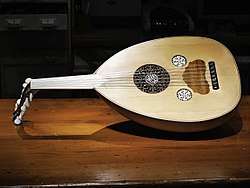 Syrian oud made by Abdo Nahat in 1921 | |
| String instrument | |
|---|---|
| Classification |
|
| Hornbostel–Sachs classification | 321.321-6 (Composite chordophone sounded with a plectrum) |
| Related instruments | |
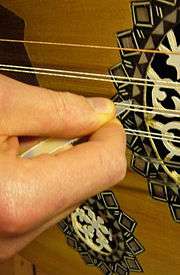
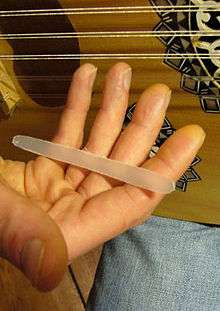
The oud is very similar to modern lutes, and also to Western lutes.[5] The modern oud is most likely derived from the Assyrian Lute. Similar instruments have been used in the Middle East, North Africa, and Central Asia for thousands of years, including Mesopotamia, Egypt, North Africa, the Caucasus, the Levant, and Balkanic countries like Greece, Albania and Bulgaria; there may even be prehistoric antecedents of the lute.[6] The oud, as a fundamental difference with the western lute, has no frets and a smaller neck. It is the direct successor of the Persian Barbat lute.[7]. It is the principal instrument of the Arab world, Somalia and Djibouti, and is of secondary importance in Turkey (ut, a spelling used in the past but now superseded by ud), Iran, Armenia and Azerbaijan (ud). It plays a lesser role in Greece (outi), where it has given rise to a long-necked model (laouto); the latter is used in rustic and folk contexts, while the ʿūd retains pre-eminently educated and urban associations. In eastern Africa it is known as udi; in recent decades it has also appeared in Mauritania and Tajikistan. [...] The emergence of the ʿūd on the stage of history is an equally complex matter. Two authors of the end of the 14th century (Abū al-Fidā, or Abulfedae, and Abū al-Walīd ibn Shihnāh) place it in the reign of the Sassanid King Sh[ā]pūr I (241–72). Ibn Shihnāh added that the development of the ʿūd was linked to the spread of Manicheism, and its invention to Manes himself, a plausible theory because the disciples of Manes encouraged musical accompaniments to their religious offices. Reaching China, their apostolate left traces of relations between West and East, seen in a short-necked lute similar to the ʿūd (Grünwedel, 1912). But the movement's centre was in southern Iraq, whence the ʿūd was to spread towards the Arabian peninsula in the 7th century. However, the texts mentioning the introduction to Mecca of the short-necked lute as the ʿūd were all written in the 9th and 10th centuries. The ʿūd spread to the West by way of Andalusia|via=Oxford Music Online}}</ref> The oldest surviving oud is thought to be in Brussels, at the Museum of Musical Instruments.[8]
An early description of the "modern" oud was given by 11th-century musician, singer and author Al-Hasan Ibn al-Haytham : أبو علي، الحسن بن الحسن بن الهيثم (c. 965 – c. 1040) in his compendium on music Ḥāwī al-Funūn wa Salwat al-Maḥzūn. The first known complete description of the ‛ūd and its construction is found in the epistle Risāla fī-l-Luḥūn wa-n-Nagham by 9th-century Philosopher of the Arabs Yaʻqūb ibn Isḥāq al-Kindī.[9] Kindī's description stands thus:
"[and the] length [of the ‛ūd] will be: thirty-six joint fingers – with good thick fingers – and the total will amount to three ashbār.[Notes 1] And its width: fifteen fingers. And its depth seven and a half fingers. And the measurement of the width of the bridge with the remainder behind: six fingers. Remains the length of the strings: thirty fingers and on these strings take place the division and the partition, because it is the sounding [or "the speaking"] length. This is why the width must be [of] fifteen fingers as it is the half of this length. Similarly for the depth, seven fingers and a half and this is the half of the width and the quarter of the length [of the strings]. And the neck must be one third of the length [of the speaking strings] and it is: ten fingers. Remains the vibrating body: twenty fingers. And that the back (soundbox) be well rounded and its "thinning"(kharţ) [must be done] towards the neck, as if it had been a round body drawn with a compass which was cut in two in order to extract two ‛ūds".[10]
In Pre-Islamic Arabia and Mesopotamia, the oud had only three strings, with a small musical box and a long neck without any tuning pegs. But during the Islamic era the musical box was enlarged, a fourth string was added, and the base for the tuning pegs (Bunjuk) or pegbox was added. In the first centuries of (pre-Islamic) Arabian civilisation, the oud had four courses (one string per course — double-strings came later), tuned in successive fourths. Curt Sachs said they were called (from lowest to highest pitch) bamm, maṭlaṭ, maṭnā and zīr.[11] "As early as the ninth century" a fifth string ḥād ("sharp") was sometimes added "to make the range of two octaves complete".[11] It was highest in pitch, placed lowest in its positioning in relation to other strings. Modern tuning preserves the ancient succession of fourths, with adjunctions (lowest or highest courses), which may be tuned differently following regional or personal preferences. Sachs gives one tuning for this arrangement of five pairs of strings, d, e, a, d', g'.[11]
Historical sources indicate that Ziryab (789–857) added a fifth string to his oud.[12] He was well known for founding a school of music in Andalusia, one of the places where the oud or lute entered Europe. Another mention of the fifth string was made by Al-Hasan Ibn al-Haytham in Ḥāwī al-Funūn wa Salwat al-Maḥzūn.
Names and etymology
The Arabic: العود (al-ʿūd or oud) literally denotes a thin piece of wood similar to the shape of a straw. It may refer to the wooden plectrum traditionally used for playing the oud, to the thin strips of wood used for the back, or to the wooden soundboard that distinguishes it from similar instruments with skin-faced bodies.[13] Henry George Farmer considers the similitude between al-ʿūd and al-ʿawda ("the return" – of bliss).[14]
Oud means "from wood" and "stick" in Arabic.[15][16] Multiple theories have been proposed for the origin of the Arabic name. A music scholar by the name of Eckhard Neubauer suggested that oud may be an Arabic borrowing from the Persian word rōd or rūd, which meant string.[17][18] Another researcher, archaeomusicologist Richard J. Dumbrill, suggests that rud came from the Sanskrit rudrī (रुद्री, meaning "string instrument") and transferred to Arabic (a Semitic language) through a Semitic language.[19] However, another theory according to Semitic language scholars, is that the Arabic ʿoud is derived from Syriac ʿoud-a, meaning "wooden stick" and "burning wood"—cognate to Biblical Hebrew ’ūḏ, referring to a stick used to stir logs in a fire.[20][21]
Names for the instrument in different languages include Arabic: عود ʿūd or ʿoud (Arabic pronunciation: [ʕu(ː)d, ʢuːd], plural: أعواد aʿwād), Armenian: ուդ, Syriac: ܥܘܕ ūd, Greek: ούτι oúti, Hebrew: עוּד ud, Persian: بربط barbat (although the barbat is a different lute instrument), Turkish: ud or ut,[22] Azeri: ud, and Somali: cuud or kaban.
History
Musical instruments from pre-history

The complete history of the development of the lute family is not fully compiled at this date, but archaeomusicologists have worked to piece together a lute family history. The highly influential organologist Curt Sachs distinguished between the "long-necked lute" and the short-necked variety.[23] Douglas Alton Smith argues the long-necked variety should not be called lute at all because it existed for at least a millennium before the appearance of the short-necked instrument that eventually evolved into what is now known the lute.[24]
Musicologist Richard Dumbrill today uses the word more categorically to discuss instruments that existed millennia before the term "lute" was coined.[25] Dumbrill documented more than 3000 years of iconographic evidence for the lutes in Mesopotamia, in his book The Archaeomusicology of the Ancient Near East. According to Dumbrill, the lute family included instruments in Mesopotamia prior to 3000 BC.[26] He points to a cylinder seal as evidence; dating from c. 3100 BC or earlier (now in the possession of the British Museum); the seal depicts on one side what is thought to be a woman playing a stick "lute".[26][27] Like Sachs, Dumbrill saw length as distinguishing lutes, dividing the Mesopotamian lutes into a long-necked variety and a short.[28] He focuses on the longer lutes of Mesopotamia, and similar types of related necked chordophones that developed throughout ancient world: Greek, Egyptian (in the Middle Kingdom), Elamites, Hittite, Roman, Bulgar, Turkic, Indian, Chinese, Armenian/Cilician, Canaanite/Phoenician, Israelite/Judean, and various other cultures. He names among the long lutes, the pandura, the panduri, tambur and tanbur[29]
The line of short-necked lutes was further developed to the east of Mesopotamia, in Bactria and Gandhara, into a short, almond-shaped lute.[13][30][31] Curt Sachs talked about the depictions of Ganharan lutes in art, where they are presented in a mix of "Northwest Indian art" under "a strong Greek influences."[32] The short-necked lutes in these Gandhara artworks were "the venerable ancestor of the Islamic, the Sino-Japanese and the European lute families."[32] He described the Ganhara lutes as having a "pear-shaped body tapering towards the short neck, a frontal stringholder, lateral pegs, and either four or five strings."[32] The oldest images of short-necked lutes from the area that Sachs knew of were "Persian figurines of the 8th century B.C.," found in excavations at Suza, but he knew of nothing connecting these to the Oud-related Ganharan art 8 centuries later.[32]
Gandhara to Spain, the Persian barbat and Arab oud go to Europe
Bactria and Gandhara became part of the Sasanian Empire (224–651). Under the Sasanians, a short almond shaped lute from Bactria came to be called the barbat or barbud, which was developed into the later Islamic world's oud or ud.[33] The oud is most likely the combination of the Barbat, with the Ancient Greek Barbiton, giving the Barbat a lower pitched tone and the playing of Maqams in Middle Eastern and Byzantine music. When the Moors conquered Andalusia in 711, they brought their ud along, into a country that had already known a lute tradition under the Romans, the pandura.
During the 8th and 9th centuries, many musicians and artists from across the Islamic world flocked to Iberia.[34] Among them was Abu l-Hasan ‘Ali Ibn Nafi‘ (789–857),[35][36] a prominent musician who had trained under Ishaq al-Mawsili (d. 850) in Baghdad and was exiled to Andalusia before 833 AD. He taught and has been credited with adding a fifth string to his oud[33] and with establishing one of the first schools of music in Córdoba.[37]
By the 11th century, Muslim Iberia had become a center for the manufacture of instruments. These goods spread gradually to Provence, influencing French troubadours and trouvères and eventually reaching the rest of Europe. While Europe developed the lute, the oud remained a central part of Arab music, and broader Ottoman music as well, undergoing a range of transformations.[38]
Although the major entry of the short lute was in western Europe, leading to a variety of lute styles, the short lute entered Europe in the East as well; as early as the sixth century, the Bulgars brought the short-necked variety of the instrument called Komuz to the Balkans.
Origins Theory from religious and philosophical beliefs
According to Abū Ṭālib al-Mufaḍḍal (a-n-Naḥawī al-Lughawī) ibn Salma (9th century), who himself refers to Hishām ibn al-Kullā, the oud was invented by Lamech, the descendant of Adam and Cain.[39] Another hypothetical attribution says that its inventor was Mani.[40] Ibn a-ṭ-Ṭaḥḥān adds two possible mythical origins: the first involves the Devil, who would have lured the "People of David" into exchanging (at least part of) their instruments with the oud. He writes himself that this version is not credible. The second version attributes, as in many other cultures influenced by Greek philosophy, the invention of the oud to "Philosophers".[9]
Central Asia
One theory is that the oud originated from the Persian instrument called a barbat (Persian: بربط ) or barbud, a lute indicated by Marcel-Dubois to be of Central Asian origin. The earliest pictorial image of the barbat dates back to the 1st century BC from ancient northern Bactria and is the oldest evidence of the existence of the barbat.[7] Evidence of a form of the barbaṭ is found in a Gandhara sculpture from the 2nd-4th centuries AD which may well have been introduced by the Kushan aristocracy, whose influence is attested in Gandharan art.[7] The name barbat itself meant short-necked lute in Pahlavi, the language of the Sasanian Empire, through which the instrument came west from Central Asia to the Middle East, adopted by the Persians.[13][41]
The barbat (possibly known as mizhar, kirān, or muwatter, all skin topped versions) was used by some Arabs in the sixth century.[42] At the end of the 6th century, a wood topped version of the Persian-styled instrument was constructed by al Nadr, called "ūd", and introduced from Iraq to Mecca.[42] This Persian-style instrument was being played there in the seventh century.[42] Sometime in the seventh century it was modified or "perfected" by Mansour Zalzal, and the two instruments (barbat and "ūd shabbūt") were used side by side into the 10th century, and possibly longer.[42] The two instruments have been confused by modern scholars looking for examples, and some of the ouds identified may possibly be barbats.[42] Examples of this cited in the Encyclopedia of Islam include a lute in the Cantigas de Santa Maria and the frontispiece from The Life and Times of Ali Ibn ISA by Harold Bowen.[42]
The oldest pictorial record of a short-necked lute-type vīnā around the 1st to 3rd centuries AD.[43] The site of origin of the oud seems to be Central Asia.[44] The ancestor of the oud, the barbat was in use in pre-Islamic Persia. Since the Safavid period, and perhaps because of the name shift from barbat to oud, the instrument gradually lost favor with musicians.[45]
The Turkic peoples had a similar instrument called the kopuz.[46] This instrument was thought to have magical powers and was brought to wars and used in military bands. This is noted in the Göktürk monument inscriptions. The military band was later used by other Turkic state's armies and later by Europeans.[47]
Types
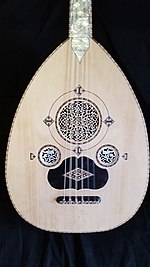
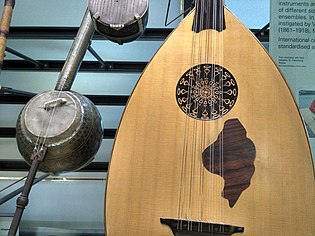
Arabian oud, Turkish oud, and Persian barbat
Modern-day ouds fall into three categories: Arabian, Turkish, and Persian, the latter also being known locally as a barbat.[48]
This distinction is not based solely on geography; the Arabic oud is found not only in the Arabian peninsula but throughout the Arab-world.[49] Turkish ouds have been played in Greece, where they are called outi, and in other locations in the Mediterranean.[50] The Arabian ouds, such as the Iraqi oud, Egyptian oud and Syrian oud, are normally grouped under the term 'Arabian oud' because of their similarities, although local differences may occur, notably with the Iraqi oud.[51] However, all these categories are very recent, and do not do justice to the variety of ouds made in the 19th century, and also today.[52]
Arabian ouds are normally larger than their Turkish and Persian counterparts, producing a fuller, deeper sound, whereas the sound of the Turkish oud is more taut and shrill, not least because the Turkish oud is usually (and partly) tuned one whole step higher than the Arabian.[53] Turkish ouds tend to be more lightly constructed than Arabian with an unfinished sound board, lower string action and with string courses placed closer together. Turkish ouds also tend to be higher pitched and have a "brighter timbre."[54] Arabian ouds have a scale length of between 61 cm and 62 cm in comparison to the 58.5 cm scale length for Turkish. There exists also a variety of electro-acoustic and electric ouds.[55]
The modern Persian Barbat resembles the oud, although differences include a smaller body, longer neck, a slightly raised fingerboard, and a sound that is distinct from that of the oud.[48] See more information at the page: Barbat (lute).
The Cümbüş is a Turkish instrument that started as a hybrid of the oud and the banjo.
Tuning
Different ways of tuning the oud exist within the different oud traditions. Among those playing the oud in the Arabic tradition, a common older pattern of tuning the strings is (low pitch to high): D2 G2 A2 D3 G3 C4 on single string courses or D2, G2 G2, A2 A2, D3 D3, G3 G3, C4 C4 for a course of two strings.[56][57] In the Turkish tradition, the "Bolahenk" tuning, is common, (low pitch to high): C#2 F#2 B2 E3 A3 D4 on instruments with single string courses or C#2, F#2 F#2, B2 B2, E3 E3, A3 A3, D4 D4 on instruments with courses of two strings.[56][57] The C2 and F2 are actually tuned 1/4 of a tone higher than a normal c or f in the Bolahenk system.[56][57]
Many current Arabic players use this tuning: C2 F2 A2 D3 G3 C4 on the standard tuning instruments, and some use a higher pitch tuning, F A D G C F
Zenne oud
The Zenne oud, often translated as a women's oud or female oud is a smaller version of the oud designed for those with smaller hands and fingers.[58] It usually has a scale length of 55–57 cm, instead of the 60–62 cm of the Arabic oud, and the 58.5 cm of the Turkish oud.[56]
Oud arbi and oud ramal
The oud arbi is a North African variant of the oud with a longer neck and only 4 courses.[59][60][61][62] It is not to be confused with the differently shaped and tuned Kwitra. The Oud Arbi is tuned in a re-entrant tuning of G3 G3, E4 E4, A3 A3, D4 D4. [63][64]
Oud Kumethra
The oud kumethra', also known as pregnant oud or pear oud is an oud with the body in a pear-like shape. This type is relatively uncommon and mostly from Egypt. [65][66]</ref>[67][68]
See also
- Arabic music
- Arabic Oud House
- Armenian music
- Byzantine music
- Hebrew music/Jewish music
- List of oud makers
- List of oud players
- Middle Eastern and North African music traditions
- Somali music
- Turkish music
- Zaidoon Treeko
Notes
- The shibr (singular of ashbār) is a measurement unit which equals roughly 18-24 cm, depending on the hand. It equates to the measured length between the tip of the thumb and the tip of the auricular finger when stretched flat and in opposite directions. The shibr otherwise measures 12 fingers (36:3): a 'full' finger should be about 2 cm in width.
References
- "The Arab World". 1971.
- "Arab Perspectives". 1984.
- "oud - Definition of oud in English by Oxford Dictionaries". Oxford Dictionaries - English. Archived from the original on 3 April 2019. Retrieved 3 October 2018.
- Mackle, Jenna (July 5, 2020). "The Oud Instrument".
- Mottola, R. M. (Summer–Fall 2008). "Constructing the Middle Eastern Oud with ter Kyvelos". American Lutherie (94, 95).
- Dumbrill, Richard J. (2005). The archaeomusicology of the Ancient Near East. Victoria, B.C.: Trafford. p. 308. ISBN 9781412055383. OCLC 62430171.
- During, J. "BARBAT". Encyclopaedia Iranica.
- "Alexandria to Brussels, 1839". oudmigrations. Retrieved 2016-04-15.
- Beyhom, Amine (2010). Théories de l'échelle et pratiques mélodiques chez les Arabes – Volume 1 : L'échelle générale et les genres – Tome 1 : Théories gréco-arabes de Kindī (IXe siècle) à Ṭūsī (XIIIe siècle). Paris: Geuthner. ISBN 978-2-7053-3840-4.
- Beyhom, Amine (2011). Paper for "The Oud from its Sumerian Origins to Modern Times", ICONEA Conference 2011 – 1–3 December 2011. "Two persistent misapprehensions about the ʿūd" (PDF). Iconea 2011: 81–110 (85).
- Sachs, Curt (1940). The History of Musical Instruments. New York: W. W. Norton & Company. p. 254.
classic number of strings was four pairs...bamm, maṭlaṭ, maṭnā, zīr...A fifth pair of strings, above zīr seems to have been introduced as early as the ninth century...
- "Iraq". 1984.
- During, Jean (1988-12-15). "Encyclopaedia Iranica - Barbat". Iranicaonline.org. Retrieved 2012-02-04.
- Farmer, Henry George (1939). "The Structure of the Arabian and Persian Lute in the Middle Ages". Journal of the Royal Asiatic Society (1): 41–51 (49). JSTOR 25201835.
...from a work entitled Kitāb kashf al-humūūm...'ūd (lute) is derived from al-'awda ("the return" meaning the days of pleasure may return [in the joy of the music of the lute]...)
- Kurtz, Glenn (2008-11-19). Practicing: A Musician's Return to Music. ISBN 9780307489760.
- Humphrey, Andrew (2009). Egypt. ISBN 9781426205217.
- Douglas Alton Smith. A History of the Lute from Antiquity to the Renaissance. p. 9. Lute Society of America (LSA), 2002. ISBN 0-9714071-0-X.
- "Asian Music Tribal Music of India, 32, 1, Fall, 2000/ Winter, 2001". Utexas.edu. Archived from the original on 2008-12-20. Retrieved 2010-12-23.
- Dumbrill, Richard J. (1998). The Archaeomusicology of the Ancient Near East. London: Tadema Press. p. 319.
‘rud’ comes from the Sanskrit ‘rudrī’, which means ‘stringed instrument’... The word spreads on the one hand via the Indo-European medium into the Spanish ‘rota’; French ‘rotte’; Welsh ‘crwth’, etc, and on the other, via the Semitic medium, into Arabic ‘ud ; Ugaritic ‘d ; Spanish ‘laúd’; German ‘Laute’; French ‘luth’...
- "Search Entry". www.assyrianlanguages.org. Retrieved 3 October 2018.
- "Strong's Hebrew: 181. אוּד (ud) -- a brand, firebrand". biblehub.com. Retrieved 2018-03-24.
- Güncel Türkçe Sözlük'te Söz Arama Archived 2007-03-11 at the Wayback Machine (in Turkish)
- Sachs, Curt (1940). The History of Musical Instruments. New York: W. W. Norton & Company. pp. 251, 253.
- Smith, Douglas Alton (2002). A History of the Lute from Antiquity to the Renaissance. Lute Society of America (LSA). ISBN 978-0-9714071-0-7.
- Dumbrill, Richard J. (2005). The archaeomusicology of the Ancient Near East. Victoria, B.C.: Trafford. pp. 305–310. ISBN 9781412055383. OCLC 62430171.
The long-necked lute would have stemmed from the bow-harp and eventually became the tunbur; and the fat-bodied smaller lute would have evolved into the modern Oud....the lute pre-dated the lyre which can therefore be considered as a development of the lute, rather than the contrary, as had been thought until quite recently...Thus the lute not only dates but also locates the transition from musical protoliteracy to musical literacy...
- Dumbrill 1998, p. 321
- https://www.britishmuseum.org/research/collection_online/collection_object_details.aspx?objectId=1447477&partId=1&people=24615&peoA=24615-3-17&page=1 British Museum, Cylinder Seal, Culture/period Uruk, Date 3100BC (circa1), Museum number 41632.
- Dumbrill 1998, p. 310
- Dumbrill, Richard J. (2005). The Archaeomusicology of the Ancient Near East. Victoria, British Columbia: Trafford Publishing. pp. 319–320. ISBN 978-1-4120-5538-3.
The long-necked lute in the OED is orthographed as tambura; tambora, tamera, tumboora; tambur(a) and tanpoora. We have an Arabic Õunbur; Persian tanbur; Armenian pandir; Georgian panturi. and a Serbo-Croat tamburitza. The Greeks called it pandura; panduros; phanduros; panduris or pandurion. The Latin is pandura. It is attested as a Nubian instrument in the third century BC. The earliest literary allusion to lutes in Greece comes from Anaxilas in his play The Lyre-maker as 'trichordos'... According to Pollux, the trichordon (sic) was Assyrian and they gave it the name pandoura...These instruments survive today in the form of the various Arabian tunbar...
- Kasidah. "Pakistan, Swat Valley, Gandhara region Lute Player; From a group of Five Celestial Musicians, 4th-5th century Sculpture; Stone, Gray schist, 10 1/8 x 4 3/4 x 2 1/2 in. (25.7 x 12.1 x 6.4 cm)". Pinterest.com. Retrieved March 25, 2015. Musician playing a 4th-to-5th-Century lute, excavated in Gandhara, and part of a Los Angeles County Art Museum collection of Five Celestial Musicians
- "Bracket with two musicians 100s, Pakistan, Gandhara, probably Butkara in Swat, Kushan Period (1st century-320)". The Cleveland Museum of Art. Retrieved March 25, 2015.
- Sachs, Curt (1940). The History of Musical Instruments. New York: W. W. Norton & Company. pp. 159–161.
- "Encyclopaedia Iranica – Barbat". Iranicaonline.org. 1988-12-15. Retrieved 2012-02-04.
- Menocal, María Rosa, Raymond P. Scheindlin, Michael Anthony Sells (eds.) (2000), The Literature of Al-Andalus, Cambridge University PressCS1 maint: multiple names: authors list (link) CS1 maint: extra text: authors list (link)
- Gill, John (2008). Andalucia: A Cultural History. Oxford University Press. p. 81. ISBN 978-01-95-37610-4.
- Lapidus, Ira M. (2002). A History of Islamic Societies. Cambridge University Press. p. 311. ISBN 9780521779333.
- Davila, Carl (2009), Fixing a Misbegotten Biography: Ziryab in the Mediterranean World, Al-Masaq: Islam in the Medieval Mediterranean Vol. 21 No. 2
- "The journeys of Ottoman ouds". oudmigrations. Retrieved 2016-04-26.
- ibn Salma, Abū Ṭālib al-Mufaḍḍal (a-n-Naḥawī al-Lughawī) (1984). Kitāb al-Malāhī wa Asmāʾihā min Qibal al-Mūsīqā. Cairo - Egypt: Al-Hay’a al-Miṣriyya al-ʿĀmma li-l-Kitāb. pp. 13–14.
ذكر هشام بن الكلّى أنّ أول من عمل العود فضرب به رجل من بني قابيل، ويقال: قايين بن آدم، يقال له: لامك، وكان عمّر زمانا طويلاً، ولم يكن يولد لهُ، فتزوّج خمسين امرأة وتسرّى بمائتي سريّة [...] ثم ولد له غلام قبل أن يموت بعشر سنين، فاشتد فرحه، فلما أتت على الغلام خمس سنين مات، فجزع عليه جزعًا شديدًا، فأخذه فعلّقه على شجرة، فقال: لا تذهب صورته عن عيني حتى يتقطّع أشلاء أو أموت، فجعل لحمه يقع عن عظامه حتى بقيت الفخذ بالساق والقدم والأصابع، فأخذ عودًا فشقّه ورقّقه وجعل يؤلف بعضه على بعض، فجعل صدره على صورة الفخذ، والعنق على صورة الساق، والإبريق على قدر القدم، والملاوي كالأصابع، وعلّق عليه أوتارًا كالعروق، ثم جعل يضرب به ويبكي وينوح حتى عمي، فكان أول من ناح، وسمّى الذي اتّخذ: عودًا، لأنه اتُخذ من عود
- Poché, Christian (2007). "ʿūd". The New Grove. 26: 26 – via Oxford Music Online.
(oud; pl.: ʿīdān). Short-necked plucked lute of the Arab world, the direct ancestor of the European lute, whose name derives from al-ʿūd (“the lute”). Known both from documentation and through oral tradition, it is considered the king, sultan or emir of musical instruments, “the most perfect of those invented by the philosophers” (Ikhwān al-Safāʾ: Rasāʾil [Letters] (1957), i, 202). It is the principal instrument of the Arab world, Somalia and Djibouti, and is of secondary importance in Turkey (ut, a spelling used in the past but now superseded by ud), Iran, Armenia and Azerbaijan (ud). It plays a lesser role in Greece (outi), where it has given rise to a long-necked model (laouto); the latter is used in rustic and folk contexts, while the ʿūd retains pre-eminently educated and urban associations. In eastern Africa it is known as udi; in recent decades it has also appeared in Mauritania and Tajikistan. [...] The emergence of the ʿūd on the stage of history is an equally complex matter. Two authors of the end of the 14th century (Abū al-Fidā, or Abulfedae, and Abū al-Walīd ibn Shihnāh) place it in the reign of the Sassanid King Sh[ā]pūr I (241–72). Ibn Shihnāh added that the development of the ʿūd was linked to the spread of Manicheism, and its invention to Manes himself, a plausible theory because the disciples of Manes encouraged musical accompaniments to their religious offices. Reaching China, their apostolate left traces of relations between West and East, seen in a short-necked lute similar to the ʿūd (Grünwedel, 1912). But the movement’s centre was in southern Iraq, whence the ʿūd was to spread towards the Arabian peninsula in the 7th century. However, the texts mentioning the introduction to Mecca of the short-necked lute as the ʿūd were all written in the 9th and 10th centuries. The ʿūd spread to the West by way of Andalusia
- Blum, Stephen (20 January 2001). "Central Asia". Oxford Music Online. Oxford Music Online, Grove Music Online. doi:10.1093/gmo/9781561592630.article.05284.
The ‘ūd (lute) is believed to be a later development of a pre-Islamic Persian instrument called barbat...[was part of] eastwards diffusion of Middle Eastern and Central Asian chordophones... the pipa, likewise derived from the barbat or from its prototype
- First Encyclopaedia of Islam: 1913-1936. Leiden: BRILL. 1993. p. 986. ISBN 978-90-04-09796-4.
- Karaikudi S., Subramanian (1985). "An introduction to the Vina". Asian Music. 16 (2): 7–82 (10). doi:10.2307/833772. JSTOR 833772.
We find representations of the nissāri vinas in sculptures, paintings, terracotta figures, and coins in various parts of India […]. The lute type vina [...] is represented in Amaravati, Nagarjunakonda, Pawaya (Gupta period), Ajanta paintings (300-500 A.D.) [...]. These varieties are plucked by the right hand and played by the left hand
- Picken, Laurence (1955). "The origin of the short lute". The Galpin Society Journal. 8: 32–42 (40). doi:10.2307/842155. JSTOR 842155.
With the evidence as yet available, it is reasonable to place the site of origin of the short lute in Central Asia, perhaps among Iranised Turco-Mongols, within the area of the ancient first-century kingdom of the Kusanas. This conclusion must not be taken to exclude the possibility that short lutes first appeared somewhat earlier and somewhat further to the West-in Parthia, for example; but at present the evidence of the Kusana reliefs is the only evidence of their existence in the first century[...] The lutes of the Kusanas would seem to be the first representations of undoubted short ovoid lutes; and Fu Hsüan’s essay, one of the first texts in any language devoted to a short lute, though not to an ovoid lute.
- Lawergren, Bo (2001). "Iran". The New Grove: 521–546 (534).
- Chabrier, Jean-Claude (2008). "ʿŪd". Encyclopedia of Islam: 534.
The ḳabūs (al-Ḥid̲j̲āz), ḳabbūṣ (ʿUmān), ḳanbūṣ (Ḥaḍramawt), ḳupūz or ḳūpūz (Turkey) is a very old instrument. Ewliyā Čelebi [q.v.] says that the ḳūpūz was invented by a vizier of Meḥemmed II (d. 886/1481) named Aḥmed Pas̲h̲a Hersek Og̲h̲lu. He describes it as being a hollow instrument, smaller than the s̲h̲as̲h̲tār, and mounted with three strings (Travels, i/2, 235). On the other hand, Ibn G̲h̲aybī says that the ḳūpūz rūmī had five double strings. The instrument is no longer used by the Turks, although it has survived under the name of kobza, koboz, in Poland, Russia, and the Balkans, but here it is the lute proper and not a barbaṭ type
- Fuad Köprülü, Türk Edebiyatında İlk Mutasavvıflar (First Sufis in Turkish Literature), Ankara University Press, Ankara 1966, pp. 207, 209.; Gazimihal; Mahmud Ragıb, Ülkelerde Kopuz ve Tezeneli Sazlarımız, Ankara University Press, Ankara 1975, p. 64.; Musiki Sözlüğü (Dictionary of Music), M.E.B. İstanbul 1961, pp. 138, 259, 260.; Curt Sachs, The History of Musical Instruments, New York 1940, p. 252.
- Goldrick, Navid (16 August 2013). "Persian Oud – Barbat". majnunn music and dance. Archived from the original on 4 December 2019. Retrieved 31 March 2018.
Because of these efforts the Arabic Oud and the Barbat are now once again part of the Iranian musical landscape.
- "Oud". sonsdelorient.com. Retrieved 9 August 2018.
- "Types of ouds". arabinstruments.com. Retrieved 9 August 2018.
- "Types of Ouds : The Ultimate Oud Buyers' Guide Part 1 - Oud for Guitarists". Oud for Guitarists. 2013-09-17. Retrieved 2017-01-27.
- "The journeys of Ottoman ouds". oudmigrations. 2016-03-08. Retrieved 2016-04-26.
- "OUD CAFE - Stringing & Tuning". www.oudcafe.com. Retrieved 2017-01-27.
- "About the Turkish oud". arabinstruments.com. Retrieved 9 August 2018.
- "Types of Ouds : The Ultimate Oud Buyers' Guide Part 1 - Oud for Guitarists". 17 September 2013. Retrieved 3 October 2018.
- "Stringed Instrument Database N-O". stringedinstrumentdatabase.aornis.com. Retrieved 8 August 2018.
- Parfitt, David. "Tuning the oud". oudipedia.info. Retrieved 8 August 2018.
- "Stringed Instrument Database N-O". stringedinstrumentdatabase.aornis.com. Retrieved 8 August 2018.
Smaller version... often played by those with smaller hands....
- "The Stringed Instrument Database: N-O". stringedinstrumentdatabase.aornis.com. Retrieved 3 October 2018.
- "Andalusische Oud". khoudir-oud.com. Retrieved 3 October 2018.
- "But is it an oud? - oudmigrations". 7 March 2016. Retrieved 3 October 2018.
- "The oud of Tunisia - oudmigrations". 14 August 2017. Retrieved 3 October 2018.
- https://stringedinstrumentdatabase.aornis.com/n.htm
- https://atlasofpluckedinstruments.com/africa.htm#north
- https://atlasofpluckedinstruments.com/middle_east.htm
- https://funjdiaz.net/museo/ficha.cfm?id=58
- https://experiencesicily.com/2014/11/04/mixing-it-oud/
- http://inthegapbetween.free.fr/pierre/PROCESS_PROJECT/process_oud.pdf
Further reading
- Rebuffa, David. Il Liuto, L'Epos, (Palermo, 2012), pp. 22–34.
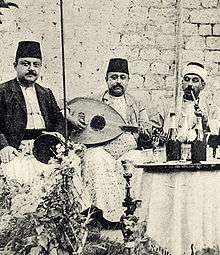
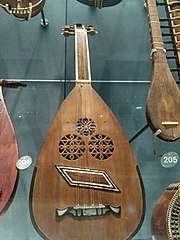
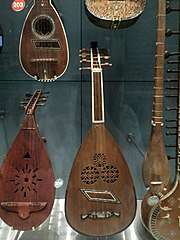
.jpg)


